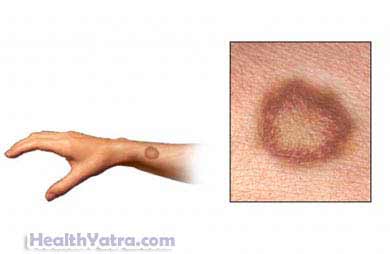Definition
Ringworm is a fungal infection of the skin. Despite its name, it has nothing at all to do with worms. Fungal infection may appear on the skin, nails, hands, feet, or scalp. Both adults and children can be affected, but it occurs most commonly in children. Fungal infection of the feet is sometimes called athlete’s foot.

Causes
Ringworm is caused by microscopic skin fungi that live on the outer layer of the skin. You can get ringworm from direct skin-to-skin contact with infected people or pets. It is also transmitted by sharing hats and personal hair grooming items (eg, hairbrushes, combs), and through contact with locker room floors, shower stalls, seats, or clothing used by an infected person.
Risk Factors
A risk factor is something that increases your chance of getting a disease or condition. Risk factors for developing ringworm include:
- Contact with surfaces (eg, seat backs, shower stalls), clothing, or personal grooming items used by an infected person
- Skin-to-skin contact with an infected person or pet
- Age: 12 or younger—ringworm of the scalp rarely occurs in children after puberty or in adults
- Spending time in nurseries, schools, daycare centers, or locker rooms
Symptoms
When ringworm appears on the skin, it makes circular, reddish patches with raised borders. Eventually, the patches grow larger, and the centers of the patches turn clear, giving a ring-like appearance.
Symptoms of ringworm on other parts of the body vary, for example:
- Scalp, tinea capitis —begins with small bumps on the head that grow larger and form a circular pattern
- Hair may become brittle and break, forming scaly, hairless patches.
- Hands, tinea manus —affects the palms and spaces between the fingers
- Feet, tinea pedis or athlete’s foot—may cause scaling between the toes, or thickening and scaling on the heels or soles
- Nails, tinea unguium —causes fingernails and toenails to become yellow, thick, and crumbly
- Groin, tinea cruris or jock itch—causes a chafed, reddish, itchy, sometimes painful rash in the groin
- Body, tinea corporis —produces flat, scaly, round spots on the skin
- Face, tinea faciei —produces red, scaly patches on the face
Ringworm symptoms on the body usually appear 4-10 days after exposure. Scalp symptoms will appear in 10-14 days.
Diagnosis
The doctor will ask about your symptoms and medical history and examine your skin. Ringworm is often easily diagnosed by appearance. However, symptoms may be similar to other conditions. A sample of the affected area may be taken for testing.
Treatment
Treatment can be oral (taken by mouth) or topical (applied to skin):
Topical Treatment
This type of treatment is used for ringworm of the skin or body. It includes antifungal creams and powders. It usually takes at least two weeks for the ringworm to clear. After ringworm clears, treatment is usually continued for at least two more weeks.
For ringworm involving the body, hands, or feet, nonprescription treatment is highly effective. The following are some of the available treatments that can cure ringworm:
- Tolnaftate
- Miconazole
- Terbinafine
- Clotrimazole
- Butenafine
- Naftifine
Terbinafine is more effective than the other medicines. Its major advantage is length of treatment. It usually only needs to be used for one week instead of the four weeks indicated above. However, it is more expensive than the alternatives and needs to be used twice daily. Other treatments may only need to be used once a day.
Oral Treatment
This type of treatment is used for ringworm of the nails and scalp. Early treatment for scalp ringworm is important to prevent permanent hair loss. A culture or other test may be given to get an accurate diagnosis before beginning this kind of treatment. Prescription pills are given for:
- Scalp ringworm: 4-8 weeks, and occasionally longer
- Nail ringworm: 4-9 months, and occasionally longer
If you developed ringworm from your pet, your pet should be treated as well. Check with your veterinarian for treatment procedures.
Prevention
The following steps may prevent ringworm:
- Avoid contact with any infected person, animal, surface, or object.
- Do not share personal hair grooming items, clothing, or shoes.
- Wear sandals in locker room areas.
- Avoid scratching during infection, to prevent ringworm from spreading to other areas.
- Wear clothing that minimizes sweating and moisture build-up.
- Wear breathable shoes or sandals.
- Keep moisture-prone areas of the body clean and dry.
